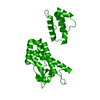+ Open data
Open data
- Basic information
Basic information
| Entry | Database: EMDB / ID: EMD-12485 | |||||||||||||||
|---|---|---|---|---|---|---|---|---|---|---|---|---|---|---|---|---|
| Title | Structure of the mature RSV CA lattice: T=1 CA icosahedron | |||||||||||||||
 Map data Map data | RSV CA T=1 particle | |||||||||||||||
 Sample Sample |
| |||||||||||||||
 Keywords Keywords | Retrovirus / Rous sarcoma virus / capsid protein / IP6 / VIRAL PROTEIN | |||||||||||||||
| Function / homology |  Function and homology information Function and homology informationhost cell nucleoplasm / viral procapsid maturation / host cell nucleolus / Hydrolases; Acting on peptide bonds (peptidases); Aspartic endopeptidases / viral capsid / structural constituent of virion / aspartic-type endopeptidase activity / nucleic acid binding / viral translational frameshifting / host cell plasma membrane ...host cell nucleoplasm / viral procapsid maturation / host cell nucleolus / Hydrolases; Acting on peptide bonds (peptidases); Aspartic endopeptidases / viral capsid / structural constituent of virion / aspartic-type endopeptidase activity / nucleic acid binding / viral translational frameshifting / host cell plasma membrane / proteolysis / zinc ion binding / membrane Similarity search - Function | |||||||||||||||
| Biological species |  Rous sarcoma virus (strain Prague C) / Rous sarcoma virus (strain Prague C) /  Rous sarcoma virus - Prague C Rous sarcoma virus - Prague C | |||||||||||||||
| Method | single particle reconstruction / cryo EM / Resolution: 3.1 Å | |||||||||||||||
 Authors Authors | Obr M / Ricana CL | |||||||||||||||
| Funding support |  Austria, Austria,  United States, 4 items United States, 4 items
| |||||||||||||||
 Citation Citation |  Journal: Nat Commun / Year: 2021 Journal: Nat Commun / Year: 2021Title: Structure of the mature Rous sarcoma virus lattice reveals a role for IP6 in the formation of the capsid hexamer. Authors: Martin Obr / Clifton L Ricana / Nadia Nikulin / Jon-Philip R Feathers / Marco Klanschnig / Andreas Thader / Marc C Johnson / Volker M Vogt / Florian K M Schur / Robert A Dick /   Abstract: Inositol hexakisphosphate (IP6) is an assembly cofactor for HIV-1. We report here that IP6 is also used for assembly of Rous sarcoma virus (RSV), a retrovirus from a different genus. IP6 is ~100-fold ...Inositol hexakisphosphate (IP6) is an assembly cofactor for HIV-1. We report here that IP6 is also used for assembly of Rous sarcoma virus (RSV), a retrovirus from a different genus. IP6 is ~100-fold more potent at promoting RSV mature capsid protein (CA) assembly than observed for HIV-1 and removal of IP6 in cells reduces infectivity by 100-fold. Here, visualized by cryo-electron tomography and subtomogram averaging, mature capsid-like particles show an IP6-like density in the CA hexamer, coordinated by rings of six lysines and six arginines. Phosphate and IP6 have opposing effects on CA in vitro assembly, inducing formation of T = 1 icosahedrons and tubes, respectively, implying that phosphate promotes pentamer and IP6 hexamer formation. Subtomogram averaging and classification optimized for analysis of pleomorphic retrovirus particles reveal that the heterogeneity of mature RSV CA polyhedrons results from an unexpected, intrinsic CA hexamer flexibility. In contrast, the CA pentamer forms rigid units organizing the local architecture. These different features of hexamers and pentamers determine the structural mechanism to form CA polyhedrons of variable shape in mature RSV particles. | |||||||||||||||
| History |
|
- Structure visualization
Structure visualization
| Movie |
 Movie viewer Movie viewer |
|---|---|
| Structure viewer | EM map:  SurfView SurfView Molmil Molmil Jmol/JSmol Jmol/JSmol |
| Supplemental images |
- Downloads & links
Downloads & links
-EMDB archive
| Map data |  emd_12485.map.gz emd_12485.map.gz | 27.3 MB |  EMDB map data format EMDB map data format | |
|---|---|---|---|---|
| Header (meta data) |  emd-12485-v30.xml emd-12485-v30.xml emd-12485.xml emd-12485.xml | 16 KB 16 KB | Display Display |  EMDB header EMDB header |
| Images |  emd_12485.png emd_12485.png | 248.4 KB | ||
| Filedesc metadata |  emd-12485.cif.gz emd-12485.cif.gz | 6.8 KB | ||
| Archive directory |  http://ftp.pdbj.org/pub/emdb/structures/EMD-12485 http://ftp.pdbj.org/pub/emdb/structures/EMD-12485 ftp://ftp.pdbj.org/pub/emdb/structures/EMD-12485 ftp://ftp.pdbj.org/pub/emdb/structures/EMD-12485 | HTTPS FTP |
-Validation report
| Summary document |  emd_12485_validation.pdf.gz emd_12485_validation.pdf.gz | 349.8 KB | Display |  EMDB validaton report EMDB validaton report |
|---|---|---|---|---|
| Full document |  emd_12485_full_validation.pdf.gz emd_12485_full_validation.pdf.gz | 349.4 KB | Display | |
| Data in XML |  emd_12485_validation.xml.gz emd_12485_validation.xml.gz | 7.5 KB | Display | |
| Data in CIF |  emd_12485_validation.cif.gz emd_12485_validation.cif.gz | 8.6 KB | Display | |
| Arichive directory |  https://ftp.pdbj.org/pub/emdb/validation_reports/EMD-12485 https://ftp.pdbj.org/pub/emdb/validation_reports/EMD-12485 ftp://ftp.pdbj.org/pub/emdb/validation_reports/EMD-12485 ftp://ftp.pdbj.org/pub/emdb/validation_reports/EMD-12485 | HTTPS FTP |
-Related structure data
| Related structure data |  7no0MC  7no1C  7no2C  7no3C  7no4C  7no5C  7no6C  7no7C  7no8C  7no9C  7noaC  7nobC  7nocC  7nodC  7noeC  7nofC  7nogC  7nohC  7noiC  7nojC  7nokC  7nolC  7nomC  7nonC  7nooC  7nopC  7noqC M: atomic model generated by this map C: citing same article ( |
|---|---|
| Similar structure data |
- Links
Links
| EMDB pages |  EMDB (EBI/PDBe) / EMDB (EBI/PDBe) /  EMDataResource EMDataResource |
|---|
- Map
Map
| File |  Download / File: emd_12485.map.gz / Format: CCP4 / Size: 343 MB / Type: IMAGE STORED AS FLOATING POINT NUMBER (4 BYTES) Download / File: emd_12485.map.gz / Format: CCP4 / Size: 343 MB / Type: IMAGE STORED AS FLOATING POINT NUMBER (4 BYTES) | ||||||||||||||||||||||||||||||||||||||||||||||||||||||||||||
|---|---|---|---|---|---|---|---|---|---|---|---|---|---|---|---|---|---|---|---|---|---|---|---|---|---|---|---|---|---|---|---|---|---|---|---|---|---|---|---|---|---|---|---|---|---|---|---|---|---|---|---|---|---|---|---|---|---|---|---|---|---|
| Annotation | RSV CA T=1 particle | ||||||||||||||||||||||||||||||||||||||||||||||||||||||||||||
| Projections & slices | Image control
Images are generated by Spider. | ||||||||||||||||||||||||||||||||||||||||||||||||||||||||||||
| Voxel size | X=Y=Z: 1.24 Å | ||||||||||||||||||||||||||||||||||||||||||||||||||||||||||||
| Density |
| ||||||||||||||||||||||||||||||||||||||||||||||||||||||||||||
| Symmetry | Space group: 1 | ||||||||||||||||||||||||||||||||||||||||||||||||||||||||||||
| Details | EMDB XML:
CCP4 map header:
| ||||||||||||||||||||||||||||||||||||||||||||||||||||||||||||
-Supplemental data
- Sample components
Sample components
-Entire : Rous sarcoma virus - Prague C
| Entire | Name:  Rous sarcoma virus - Prague C Rous sarcoma virus - Prague C |
|---|---|
| Components |
|
-Supramolecule #1: Rous sarcoma virus - Prague C
| Supramolecule | Name: Rous sarcoma virus - Prague C / type: virus / ID: 1 / Parent: 0 / Macromolecule list: all / NCBI-ID: 11888 / Sci species name: Rous sarcoma virus - Prague C / Virus type: VIRUS-LIKE PARTICLE / Virus isolate: OTHER / Virus enveloped: No / Virus empty: Yes |
|---|---|
| Virus shell | Shell ID: 1 / Name: T=1 icosahedron |
-Macromolecule #1: Capsid protein p27, alternate cleaved 1
| Macromolecule | Name: Capsid protein p27, alternate cleaved 1 / type: protein_or_peptide / ID: 1 / Number of copies: 1 / Enantiomer: LEVO |
|---|---|
| Source (natural) | Organism:  Rous sarcoma virus (strain Prague C) / Strain: Prague C Rous sarcoma virus (strain Prague C) / Strain: Prague C |
| Molecular weight | Theoretical: 24.773594 KDa |
| Recombinant expression | Organism:  |
| Sequence | String: PVVIKTEGPA WTPLEPKLIT RLADTVRTKG LRSPITMAEV EALMSSPLLP HDVTNLMRVI LGPAPYALWM DAWGVQLQTV IAAATRDPR HPANGQGRGE RTNLNRLKGL ADGMVGNPQG QAALLRPGEL VAITASALQA FREVARLAEP AGPWADIMQG P SESFVDFA ...String: PVVIKTEGPA WTPLEPKLIT RLADTVRTKG LRSPITMAEV EALMSSPLLP HDVTNLMRVI LGPAPYALWM DAWGVQLQTV IAAATRDPR HPANGQGRGE RTNLNRLKGL ADGMVGNPQG QAALLRPGEL VAITASALQA FREVARLAEP AGPWADIMQG P SESFVDFA NRLIKAVEGS DLPPSARAPV IIDCFRQKSQ PDIQQLIRTA PSTLTTPGEI IKYVLDRQKT A UniProtKB: Gag polyprotein |
-Experimental details
-Structure determination
| Method | cryo EM |
|---|---|
 Processing Processing | single particle reconstruction |
| Aggregation state | particle |
- Sample preparation
Sample preparation
| Buffer | pH: 8 / Component - Concentration: 1.0 M / Component - Formula: NaPi / Component - Name: sodium phosphate |
|---|---|
| Grid | Model: C-flat-2/2 / Material: COPPER / Mesh: 300 / Support film - Material: CARBON / Support film - topology: HOLEY / Pretreatment - Type: GLOW DISCHARGE / Pretreatment - Time: 45 sec. / Pretreatment - Atmosphere: AIR |
| Vitrification | Cryogen name: ETHANE / Chamber humidity: 95 % / Chamber temperature: 277 K / Instrument: FEI VITROBOT MARK IV / Details: blot time= 2.5 s blot force= 0. |
- Electron microscopy
Electron microscopy
| Microscope | FEI TECNAI ARCTICA |
|---|---|
| Specialist optics | Energy filter - Name: GIF Bioquantum / Energy filter - Slit width: 20 eV |
| Image recording | Film or detector model: GATAN K3 BIOQUANTUM (6k x 4k) / Digitization - Dimensions - Width: 5760 pixel / Digitization - Dimensions - Height: 4092 pixel / Average exposure time: 3.0 sec. / Average electron dose: 50.0 e/Å2 |
| Electron beam | Acceleration voltage: 200 kV / Electron source:  FIELD EMISSION GUN FIELD EMISSION GUN |
| Electron optics | C2 aperture diameter: 50.0 µm / Illumination mode: FLOOD BEAM / Imaging mode: BRIGHT FIELD / Cs: 2.7 mm / Nominal defocus max: 1.5 µm / Nominal defocus min: 0.8 µm / Nominal magnification: 63000 |
| Sample stage | Specimen holder model: FEI TITAN KRIOS AUTOGRID HOLDER / Cooling holder cryogen: NITROGEN |
| Experimental equipment |  Model: Talos Arctica / Image courtesy: FEI Company |
+ Image processing
Image processing
-Atomic model buiding 1
| Initial model | PDB ID: Chain - Source name: PDB / Chain - Initial model type: experimental model |
|---|---|
| Details | The CANTD and CACTD of one CA monomer of pdb 3TIR were independently placed into the EM-density using the rigid body fitting option in UCSF Chimera. Subsequently the linker connecting the two CA domains was joined in Coot. To account for the different monomer-monomer interactions in the RSV CA pentamer, the monomers were replicated according to the inherent 5-fold symmetry of the map and an additional ring of CACTDs was rigid-body fitted into the EM-densities of the surrounding CA pentamers. A map segment (defined by a mask extending 3 Angstrom around the rigid body fitted model) was extracted, and real-space coordinate refinement against the EM-density was performed using Phenix. This was iterated with manual model building in Coot, similar as described previously. In brief, secondary structure restraints and non-crystallographic symmetry (NCS) restraints were applied throughout all refinements. Each Phenix iteration consisted of 5 macro cycles, in which simulated annealing was performed in every macro cycle. Atomic displacement parameter (ADP) refinement was per formed at the end of each iteration. |
| Refinement | Space: REAL / Protocol: AB INITIO MODEL |
| Output model |  PDB-7no0: |
 Movie
Movie Controller
Controller



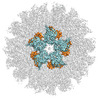



























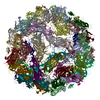
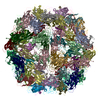

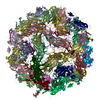
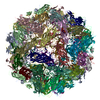
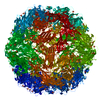
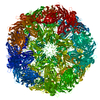
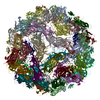
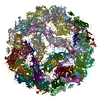
 Z (Sec.)
Z (Sec.) Y (Row.)
Y (Row.) X (Col.)
X (Col.)






















